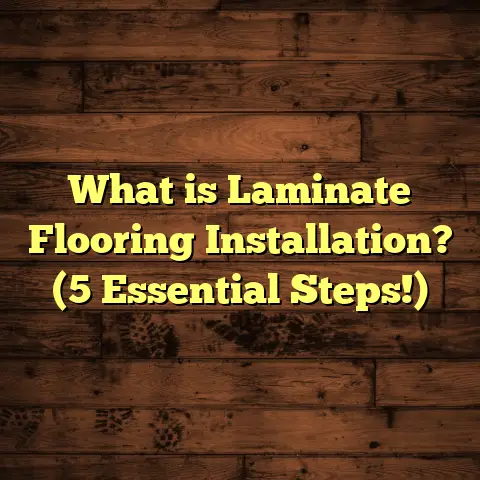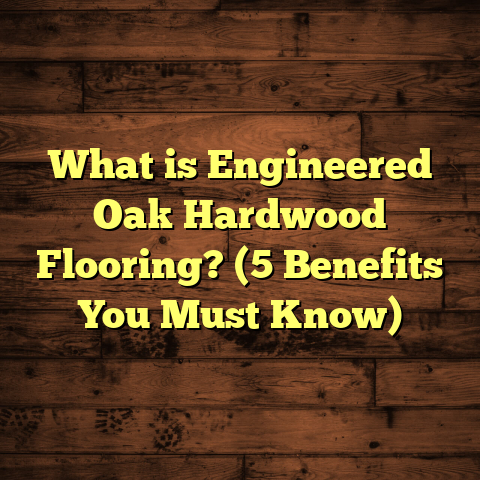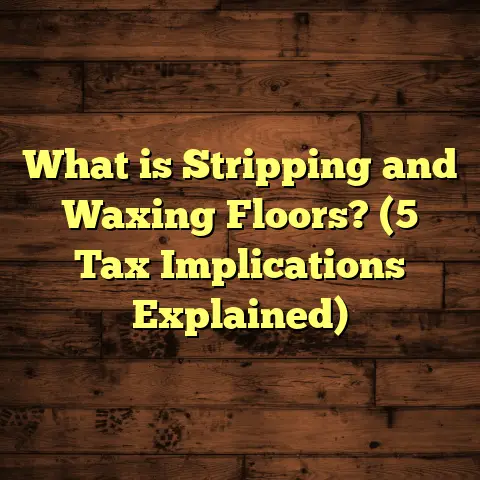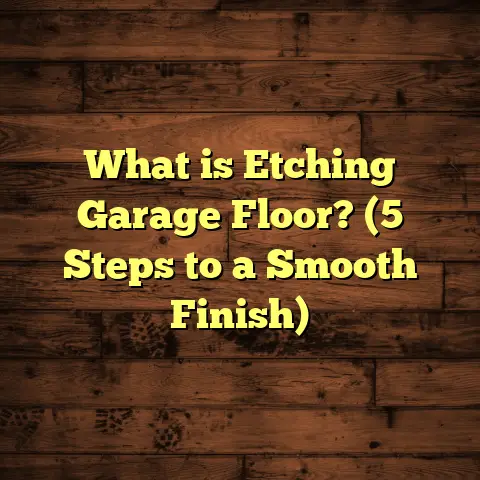What is Flooring Hierarchy? (5 Key Levels Explained)
Have you ever found yourself staring at flooring samples for what feels like forever,
wondering how to pick the right one? There are so many choices out there that it’s easy
to feel lost. I’ve been in your shoes—and after years working as a flooring contractor,
I want to share a little secret that changed how I approach flooring decisions.
It’s what I call the “flooring hierarchy.” This simple way of organizing flooring options
into five clear levels helps you cut through confusion and focus on what matters for
your home or project. Understanding this hierarchy has saved me hours of headaches
and thousands of dollars in costly mistakes, and I want it to help you too.
Let me walk you through this concept step-by-step, sprinkled with real stories,
eye-opening data, and practical tips you can use right now.
What is Flooring Hierarchy?
At its core, flooring hierarchy is a way to break down the vast world of flooring materials
and styles into five key levels or tiers. Each level groups floor choices by factors like:
- Cost
- Durability
- Installation complexity
- Maintenance requirements
- Aesthetic appeal
Think of it as a ladder—each rung represents a group of floor types with similar qualities.
Why does this matter? Because when you know where a floor fits in the hierarchy, you get
a clearer picture of what to expect in terms of price, lifespan, and how well it will hold up.
Here’s what I’ve found over hundreds of projects: Instead of getting overwhelmed by every
single brand or type on the market, narrowing your options by these five levels makes
choosing way easier—and smarter.
Why Flooring Choices Can Be So Tricky
When I first started in this business, I noticed many clients struggled with two main things:
- Not knowing what fits their lifestyle — They’d pick floors that looked great but didn’t hold up to kids and pets.
- Budget confusion — They’d either overspend or buy something so cheap it needed replacing quickly.
That’s why the flooring hierarchy isn’t just theory; it’s a practical tool I developed from real-world experience.
It helps answer important questions like:
- How much should I expect to spend?
- What floors stand up to heavy use?
- What’s worth investing in long-term?
- How hard is it to install or maintain this floor?
By the time you finish reading, you’ll see your flooring options through a new lens—and be ready to make confident choices.
Level 1: The Basics — Budget-Friendly Floors for Quick Fixes
Let’s start at the bottom rung of the ladder where you’ll find the simplest and cheapest floors. These often include:
- Vinyl sheet flooring
- Basic laminate (lower wear layer)
- Entry-level carpets
This level is great if you need something fast and affordable or are working within tight budget limits.
What Makes These Floors Work?
The main appeal here is cost and ease of installation. For example, vinyl sheets can be glued down or sometimes even loose-laid. Laminate often uses a click-lock system that’s pretty DIY-friendly.
I remember helping a client set up a rental unit with vinyl plank flooring that cost under $1.50 per sq. ft. It looked decent, was waterproof, and could withstand tenant turnover without breaking the bank.
Durability and Lifespan
These floors typically last 5 to 10 years max depending on wear and care. They aren’t designed for heavy traffic but do fine in low-use areas like guest rooms or basements.
Maintenance Tips
Cleaning is usually easy—think simple sweeping and damp mopping. One tip I always share: avoid harsh chemicals on vinyl; they can degrade the surface.
When to Choose Level 1 Floors
- You’re renting or planning short-term use
- Budget is extremely limited
- Need quick installation with minimal fuss
Watch Out For
Cheap floors can look flat or plastic-y compared to higher tiers. Also, repairs can be tricky; damage often means replacing entire sections.
Level 2: Mid-Tier Materials — Sweet Spot Between Cost and Quality
This next level brings a noticeable step up in quality and durability while still being budget-conscious. Common choices include:
- Mid-grade laminate with thicker wear layers
- Engineered hardwood with thinner veneer (about 2-3mm)
- Luxury vinyl planks (LVP) with enhanced textures
Why I Recommend These Floors Often
I had a couple who wanted hardwood looks but couldn’t afford solid wood. We went with engineered wood that had a 3mm wear layer and it looked beautiful for years—even with kids running around.
This level hits a great balance between cost (usually between $3-$6 per sq. ft.) and performance. You get better resistance to scratches, moisture, and dents than basics.
Installation
Many of these floors are still DIY-friendly but some may require professional help—especially engineered hardwood which needs acclimation and precision.
Durability & Maintenance
Expect 10-15 years of solid use if well cared for. Routine cleaning and occasional refinishing keep engineered hardwood looking fresh.
Data Point
According to industry reports, roughly 40% of U.S. homeowners pick mid-tier floors for their affordability combined with decent longevity.
Personal Tip
If you go engineered hardwood here, always check the thickness of the top veneer—thicker means more sanding cycles later on if needed.
Level 3: Premium Engineered & Solid Hardwood — Lasting Beauty
Now we reach floors that often become family heirlooms. This level includes:
- High-quality engineered wood with thick veneer (4+ mm)
- Solid hardwood floors in popular species like oak, maple, hickory
Why Choose Level 3?
I’ve installed solid oak floors that stood strong for over 30 years with just gentle sanding every decade or so. If you want timeless beauty paired with longevity, this is your zone.
Clients who plan to stay in their homes long-term tend to gravitate here because these floors add real value while aging gracefully.
Price Range
Typically $7-$12 per square foot including materials and installation.
Installation Experience
Professional installation is recommended due to acclimation needs, nailing or stapling techniques for solid wood, and ensuring even subfloor prep.
Durability & Repairs
These floors can last decades—20+ years easily—and can be sanded multiple times to remove scratches or dents.
Case Study Highlight
I tracked a project where homeowners refinished their solid oak floors twice over 25 years, maintaining the original charm while adapting to modern aesthetics through stain color changes.
Level 4: Specialty Floors — Unique Looks & Eco-Friendly Options
This level is all about personality—floors that stand out due to their materials or environmental benefits such as:
- Bamboo flooring
- Cork flooring
- Reclaimed wood floors
- Exotic hardwoods like teak or mahogany
- Porcelain or natural stone tiles
Why Specialty Floors?
I once worked on a family home where reclaimed barn wood was used throughout. The rustic character was unbeatable—each plank carried history and texture unique to that home.
Bamboo appeals due to its rapid renewability compared to traditional hardwoods. Cork offers a soft feel underfoot and natural insulation properties.
Cost Considerations
Prices vary widely ($8–$20+ per sq. ft.) depending on material rarity and installation complexity.
Maintenance Tips
Some eco-friendly floors need special care—cork is sensitive to moisture so sealing is critical; exotic hardwoods may require oiling rather than standard finishes.
Installation Notes
Specialty floors often need skilled installers familiar with unique materials or patterns.
Quick Insight
Surveys show homeowners choosing bamboo or cork value health benefits like low VOC emissions and comfort over just looks.
Level 5: Luxury & Custom Floors — Masterpieces Underfoot
At the top tier are floors made from rare materials or featuring custom craftsmanship such as:
- Hand-scraped exotic hardwoods (Brazilian cherry, walnut)
- Marble or granite tile inlays
- Custom parquet patterns with intricate designs
Who Chooses Level 5?
High-end homeowners, interior designers aiming for wow-factors, or those wanting their floor as an art piece.
A luxury home I worked on featured walnut parquet with ornate borders that took weeks of expert labor but elevated the entire space’s feel.
Price Tags
These floors command prices well over $20 per sq. ft., sometimes much more depending on custom work.
Maintenance & Longevity
They often last a lifetime with proper care but require specialized cleaning products and refinishing techniques to preserve detail.
Real Estate Impact
Homes with custom luxury flooring can see resale increases averaging 5–10% higher than similar homes without such features.
How I Use This Hierarchy On Every Project
When I meet new clients, my first question always revolves around where they see themselves on this ladder:
- Are you looking for something temporary or permanent?
- Is budget your biggest concern?
- How much wear do your floors need to withstand?
- Are you after style, function, or both?
Answering these helps me recommend a fitting level instead of throwing random samples at them.
Additional Tips Based on My Experience
Don’t Skimp on Subfloor Prep
No matter which level you choose, a well-prepared subfloor prevents future problems like squeaks or uneven wear. I’ve seen cheap floors fail early just because installers rushed this step.
Factor in Waste Percentage
Order about 5–10% extra material depending on layout complexity and waste factor. It saves frustration mid-installation.
Consider Room Use Carefully
Bathrooms might warrant water-resistant vinyl or tile at level 2 or above; kitchens often benefit from durable engineered wood at level 3; living rooms can showcase specialty or luxury floors nicely.
Let’s Talk Numbers: Flooring Cost Breakdown by Level (Material Only)
| Level | Material Cost Range (per sq.ft.) | Typical Installation Cost (per sq.ft.) | Total Avg Cost (per sq.ft.) |
|---|---|---|---|
| Level 1 | $0.75 – $2 | $0.50 – $1 | $1.25 – $3 |
| Level 2 | $2 – $6 | $1 – $2 | $3 – $8 |
| Level 3 | $5 – $10 | $2 – $4 | $7 – $14 |
| Level 4 | $8 – $20+ | $3 – $6 | $11 – $26+ |
| Level 5 | $20+ | $5+ | $25+ |
I always remind clients that labor costs vary regionally but these ranges give a solid starting point when budgeting.
Real Client Story: Choosing Flooring for a Busy Family Home
A couple contacted me unsure whether they should invest in solid hardwood or just go with laminate for their growing family home. Kids were active and pets were part of daily life. They wanted durability without sacrificing style but feared overspending.
We discussed the hierarchy levels and landed on premium engineered hardwood (Level 3). It offered the look they loved with better moisture resistance than solid wood and could handle wear better than laminate. We added a durable finish for extra scratch protection.
Two years later they reported zero issues despite busy daily use—and friends often complimented the floor’s warm look.
Wrapping Up My Flooring Hierarchy Guide
Understanding flooring hierarchy isn’t just about knowing materials—it’s about making smart choices tailored to your lifestyle and budget. Whether you’re fixing up a rental or building your dream home, matching your needs to one of these five levels will save time, money, and regret down the road.
If you want personalized advice on which level fits your project best or help calculating costs, feel free to reach out anytime—it’s what I’m here for!
Would you like me to help break down your specific space? Or maybe run some numbers based on your budget? Just say the word!





